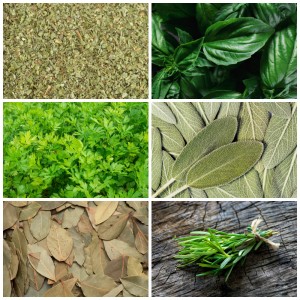
From left to right, top to bottom, meet: oregano, basil, parsley, sage, bay leaves, and rosemary!
Herbs in cooking are like the supporting cast of a movie. Sure, the main dish is delicious looking and fresh, but it would be pretty bland without all of the extras and other talented actors that make the movie — or the meal — work so well. Convoluted metaphor aside, fresh herbs are indeed the soft-spoken heroes of Italian cuisine. Taking the time to learn about them can help you recreate some of our delicious dishes at home, or at least know what those green specks on your pizza are. Let’s get started!
All About Herbs in Italian Cuisine
Ever since a culinary revolution in the early Roman Empire, Italian cuisine has been strongly influenced by the use of herbs and spices, for flavor, color, texture, and for health benefits. Here’s a brief overview of some common Italian herbs:
- Oregano — So about those green flecks on your pizza that we mentioned in the intro? That’s oregano! Oregano became popular in the US after World War I, when soldiers brought it back to America. Funnily enough, oregano isn’t nearly as popular in Italian cooking as others like parsley and basil. Most flavorful when dried, it also adds Omega-3s, iron, and antioxidants to southern Italian and Sicilian dishes.
- Basil — One of the most quintessentially “Italian” herbs, basil actually originated in India and made its way to Europe via the spice trade. Adopted with eager appetites by Italians, Basil brings lots of freshness to dishes and goes extremely well with cheese, tomato, garlic, and lemon — each of which are also quite popular ingredients in Italian cuisine.
- Parsley — Another hugely popular Italian herb, parsley is usually paired with seafood and vegetable sauces, and is incorporated in most pasta dishes, sauces, and soups. Parsley is a great companion for spicy or garlicky dishes — it’s actually a great breath freshener! It also brings vitamins A, B, and C, along with iron and magnesium.
- Sage — Used internationally for its health value, sage brings anti-inflammatory properties, and aids in digestion. In Italian cooking, it’s most commonly used in pasta dishes like gnocchi or risotto, or with roasted meats and soups.
- Bay Leaves and Rosemary — These two are grouped together because they both grow the most abundantly in Italy among this list. Bay leaves are often added to soups, sauces, and stews to build a flavor profile, or are used in flavoring meats, but aren’t actually meant to be eaten. Rosemary is used similarly, to flavor stocks and stews as well as roasted vegetables or meats. It also has plenty of iron, calcium, fiber, and antioxidants to accompany its peppery flavor.
Now next time you see some unknown green flecks and leaves in your food, you can properly identify it and know that it’s just there to make your entire Italian dining experience more delicious, fresh, and healthy.
Enjoy Italian Herbs at Basta Pasta
In 2004, Basta Pasta opened its doors to the public, and ever since has maintained the image and experience of casual Italian dining. In addition to fresh, delicious ingredients and recipes, the restaurant strives to uphold expert, attentive, and cordial service for its customers. Our Timonium location also features plenty of rooms for private parties and events. Enjoy a taste of Italy with hearty pasta dishes, endless salad and breadsticks, and fine wines right here in your hometown. For more information, visit our website.
Want to learn more about our wine selection? Need to get in touch with one of our locations? Here is some basic contact information for both:
- Timonium Location- 60 W Timonium Road
- 410-308-0838
- Online Contact Page
- Fallston Location- 2745 Fallston Road
- 410-692-5200
- Online Contact Page
How often do you “Like” and “Follow?” Be sure to find Basta Pasta on Google+, Pinterest, Facebook, Twitter, and LinkedIn today!
